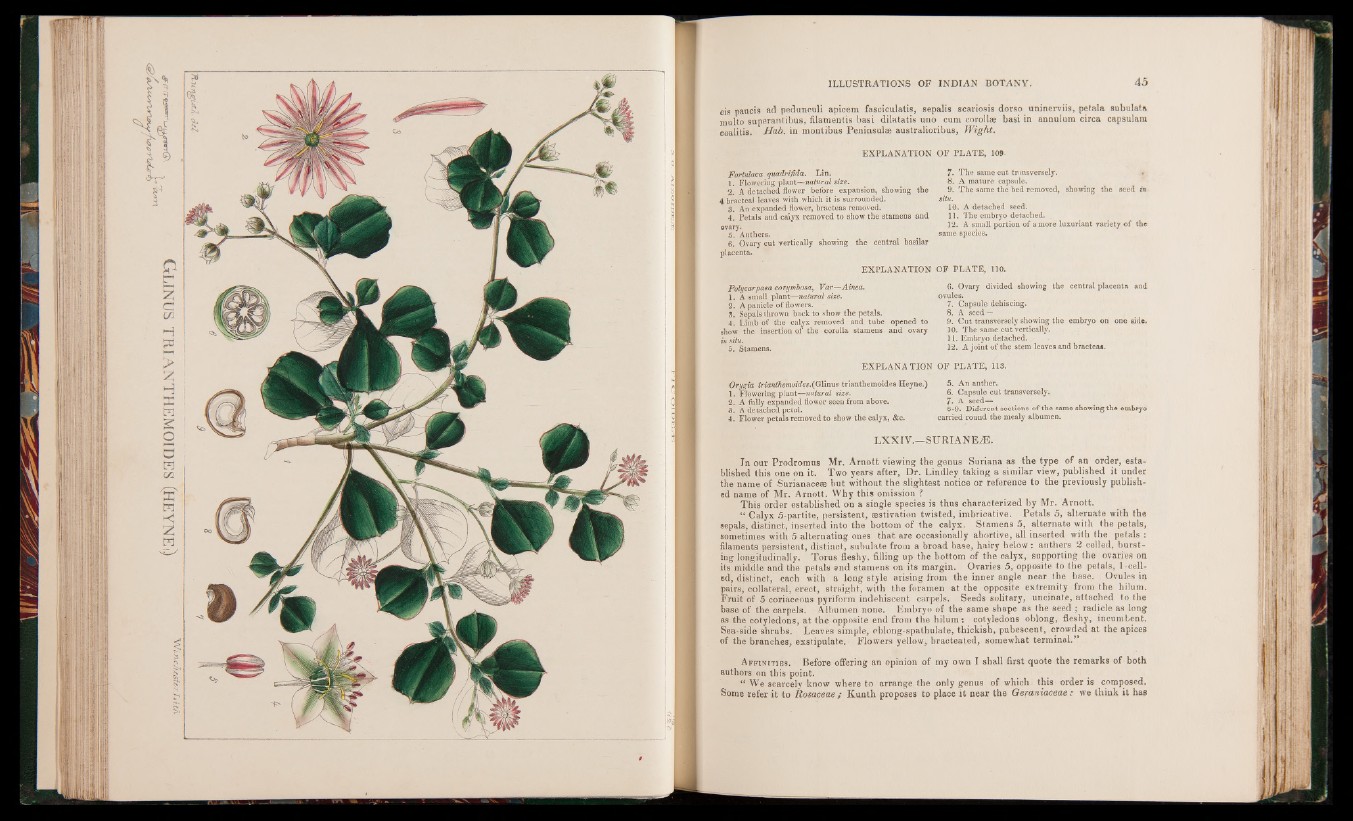
HMMB
cis paucis ad pedunnuli apicem fasciculatis, sepalis scariosis dorso uninerviis, petala subulata
niulto superantibus, filamentis basi dilatatis uno cum corollae basi in ännulum circa capsulam
coalitis. Hab. in montibus Peninsulae australioribus, Wight.
EXPLANATION
Fortulaca quadrifida. Lin.
1. Flowering plant—natural size.
2. A detached flower before expansion, showing the
4 bracteal leaves with which it is surrounded.
3. An expanded flower, bracteas removed.
4. Petals and calyx removed to show the stamens and
ovary.
5. Anthers.
6. Ovary cut vertically showing the central basilar
placenta.
EXPLANATION
Polycarpaea corymbosa, Var—Ainea.
1. A small plant—natural size.
2. A panicle of flowers.
3. Sepals thrown back to show the petals.
4. Limb of the calyx removed and tube opened to
show the insertion of the corolla stamens and ovary
in situ.
5. Stamens.
EXPLANA TION
Orygia trianthemoides.(G\m\i9 trianthemoides Heyne.)
1. Flowering plant—natural size.
2. A fully expanded flower seen from above.
3. A detached petal.
4. Flower petals removed to show the calyx, &c.
OF PLATE, 109.
7. The same cut transversely.
8. A mature capsule.
9. The same the bed removed, showing the seed in
situ.
10. A detached seed.
11. The embryo detached.
12. A small portion of a more luxuriant variety of the
same species.
OF PLATE, 110.
6. Ovary divided showing the central placenta and
ovules.
7. Capsule dehiscing.
8. A seed—
9. Cut transversely showing the embryo on one side.
10. The same .cut vertically.
11. Embryo detached. .
12. A joint of the stem leaves and bracteas.
OF PLATE, 113.
5. An anther.
6. Capsule cut transversely.
7. A seed—
8-9. Different sections o f the same showing the embryo
carried round the mealy albumen.
LXXIV.—SURIANEÆ.
In our Prodromus Mr. Arnott viewing the genus Suriana as the type of an order, established
this one on it. Two years after, Dr. Lindley taking a similar view, published it under
the name of Surianaceae but without the slightest notice or reference to the previously published
name of Mr. Arnott. Why this omission ?
This order established oh a single species is thus characterized by Mr. Arnott.
“ Calyx 5-partite, persistent, aestivation twisted, imbricative. Petals 5, alternate with the
sepals, distinct, inserted into the bottom of the calyx. Stamens 5, alternate with the petals,
sometimes with 5 alternating ones that are occasionally abortive, all inserted with the petals :
filaments persistent, distinct, subulate from a broad base, hairy below: anthers 2 celled, bursting
longitudinally. Torus fleshy, filling up the bottom of the calyx, supporting the ovaries on
its middle and the petals and stamens on its margin. Ovaries 5, opposite to the petals, 1-celled,
distinct, each with a long style arising from the inner angle near the base. Ovules in
pairs, collateral, erect, straight, with the foramen at the opposite extremity from the hilum.
Fruit of 5 coriaceous pyriform indehiscent carpels. Seeds solitary, uncinate, attached to the
base of the carpels. Albumen none. Embryo of the same shape as the seed ; radicle as long
as the cotyledons, at the opposite end from the hilum: cotyledons oblong, fleshy, incumbent.
Sea-side shrubs. Leaves simple, oblong-spathulate, thickish, pubescent, crowded at the apices
of the branches, exstipulate. Flowers yellow, bracteated, somewhat terminal.”
A ffin itie s. Before offering an opinion of my own I shall first quote the remarks of both
authors on this point.
i( We scarcely know whereto arrange the only genus of which this order is composed.
Some refer it to Rosaceae ; Kunth proposes to place it near the Geraniaceae: we think it has